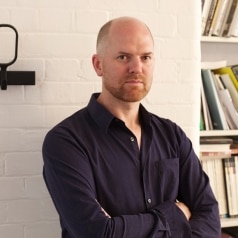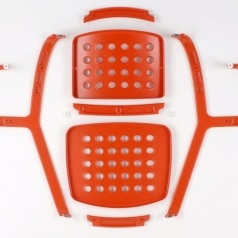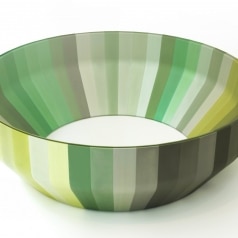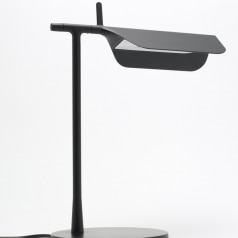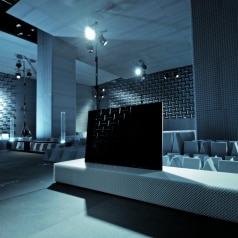Jon joined BarberOsgerby and Universal Design Studio in 2003 and has developed some of BarberOsgerby’s most iconic pieces such as the Hula Stool, De La Warr Pavilion Chair, Tab Lamp and Iris tables. Jon also directs projects for clients such as Levis, Coca Cola, Sony and Panasonic. Ahead of his attendance at this year’s Electrolux Design Lab as a jury member, Jon provides his own perspective on design and offers some advice for the 2010 finalists.
Jon was born in 1970 in Dorchester, Dorset and graduated from the Royal College of Art in 1996 with a masters degree in industrial design. He has previously worked at internationally acclaimed design studios Pentagram London and Ross Lovegrove.
What are some of your favourite product designs?
Growing up, I was inspired by products such as the Leica M4 camera, the Sony Walkman 2 and The Braun ET66 calculator. They are all logically assembled and have a rigorous attention to detail. Some more recent favourites include Konstantin Grcic’s ‘Mayday’ lamp for Flos and Naoto Fukasawa’s ‘Tray with Light’ for plus Minus Zero. They both have a functional elegance that is combined with a degree of wit, which I like very much. Finally, a true favourite, and something I use everyday, is the iconic octagonal Moka espresso maker. It was designed by Alfonso Bialetti in 1933 and is still in production almost unchanged today.
Describe your design style?
I work in a very considered, almost systematic way in order to produce and develop objects that are both functional and beautiful and fit a specific brief. I would say that at BarberOsgerby we produce enduring and functional design but, importantly, design that has a soul.
Give an example of your greatest design accomplishment so far?
I am very proud of the Tab Lamp for Flos, it is a very simple form but one which took five years of development to bring to market. Much of the time was spent actually paring down all the elements of the lamp and removing details in order to retain the simple charm of our first cardboard model. The end result has a strong character but is also a very functional, efficient design.
What kinds of projects are you working on now?
I’m currently working on an updated version of the Tab lamp, due to be launched later this year, which integrates LED technology as the light source. The LEDs have the same lighting quality and output as the current halogen version but with one fifth of the power consumption. Because they have a completely different form to the halogen lamps, we are redesigning several components to fit them into the same main body design.
What are the latest trends in colours, materials, patterns?
New developments in technology, manufacturing and materials often inform new design choices in colour, finish and pattern. Recently I have been particularly interested in the development of digital production using processes that are traditionally only used for prototyping. With these processes the raw material finish becomes more prevalent in the finished design. Our Iris tables, for example, are CNC machined from solid aluminium. The raw aluminium surface is then anodised in various colours, preserving its natural shine without coating or painting. For the Sony installation at the Milan Furniture Fair this year, we used stereolithography to make a large furniture piece. The slightly translucent colour of the resin is a feature of the design.
How important is sustainability to your work (both in term of design and choice of materials)?
Efficient design and careful use of materials not only helps the environment but reduces cost for manufacturers and end users. But there is a careful compromise to be made between reducing material use and creating good quality products that are long lasting. This adds considerable complexity to discussions about sustainability. When we designed the De La Warr Pavilion Chair, for example, we reduced weight by eliminating material in the frame castings. However, we ended up putting some material back in because our research showed that for coastal outdoor use, very lightweight chairs get easily damaged by blowing over in the wind and often need replacing.
Considering a move toward greater urbanisation, how do you think that will affect how we live our lives in the future?
It will lead to less personal space in cities, both in dwellings, public spaces and throughout the transportation infrastructure. It is important that designers and engineers come up with creative solutions to these issues. I do think, however, that there will be positives too: I hope that greater demands on cultural institutions and a more multi-cultural society will mean more choice and better quality in theatres, museums, galleries and music venues. You can already see this happening in London and it has great benefits for designers as both consumers and creators of culture.
Who or what has most inspired you as a designer?
I grew up by the sea and spent much of my childhood messing about in boats, so I would say the maritime world, both natural and man made, has been a huge inspiration. As for designers, I admire Dieter Rams and Achile Castiglioni. I spend a lot of time with Architects and draw inspiration from Architecture in general, but especially Le Corbusier, Louis Kahn, Peter Zumtor and Herzog de Muron. Aside from that, artists like Richard Wentworth and Tom Sachs have been a huge inspiration.
What advice would you give to young designers just starting their careers?
I always stress to young designers that their naivety and fresh way of thinking is often their greatest asset when they develop projects in a team. Energy and enthusiasm are really important and they should not get anxious about lack of knowledge. Be persistent, ask questions and try to meet and talk to as many people as possible in the design profession.
And what advice would you give this year’s Electrolux Design Lab finalists?
They have already all worked extremely hard to develop brilliant raw ideas so thoroughly and convincingly for presentation at this level. A great achievement! This is now their time to be in the spotlight so my advice would be to just relax and enjoy the moment, talk to as many people as possible, and make the most of this unique experience.


